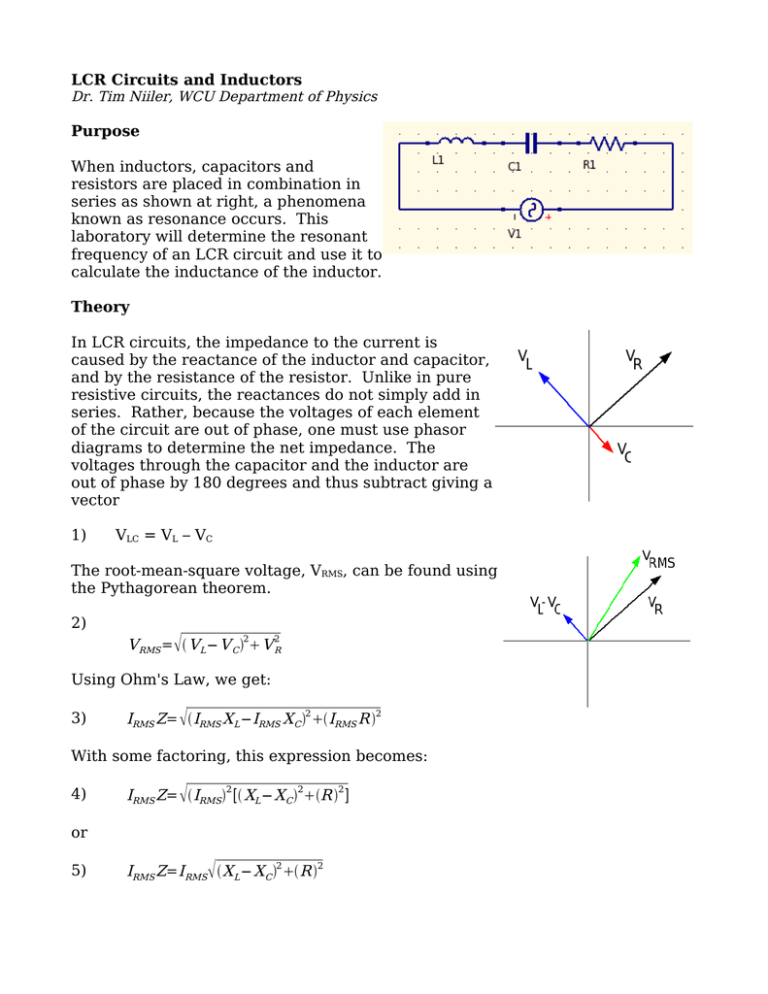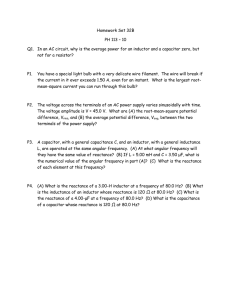LCR Circuits and Inductors Purpose When inductors, capacitors and
advertisement

LCR Circuits and Inductors
Dr. Tim Niiler, WCU Department of Physics
Purpose
When inductors, capacitors and
resistors are placed in combination in
series as shown at right, a phenomena
known as resonance occurs. This
laboratory will determine the resonant
frequency of an LCR circuit and use it to
calculate the inductance of the inductor.
Theory
In LCR circuits, the impedance to the current is
caused by the reactance of the inductor and capacitor,
and by the resistance of the resistor. Unlike in pure
resistive circuits, the reactances do not simply add in
series. Rather, because the voltages of each element
of the circuit are out of phase, one must use phasor
diagrams to determine the net impedance. The
voltages through the capacitor and the inductor are
out of phase by 180 degrees and thus subtract giving a
vector
1)
VLC = VL – VC
The root-mean-square voltage, VRMS, can be found using
the Pythagorean theorem.
2)
V RMS = V L − V C 2 V 2R
Using Ohm's Law, we get:
3)
IRMS Z= IRMS X L −IRMS X C 2 IRMS R 2
With some factoring, this expression becomes:
4)
IRMS Z= IRMS2 [ XL − X C 2R 2 ]
or
5)
IRMS Z=I RMS X L − X C 2 R 2
Finally, it can be seen that the impedance for such a circuit is:
Z= XL − X C 2R 2
When the capacitive reactance is equal to the
inductive reactance, the impedance reaches
its minimum value: Z = R. At this frequency,
the current reaches its maximum value. At
low frequencies, the capacitive reactance
dominates, while at high frequencies, the
inductive reactance dominates.
The capacitive reactance is given by:
7)
Reactance vs Frequency
Reactance (Ω)
6)
1
C
XC =
750
700
650
600
550
500
450
400
350
300
250
200
150
100
50
0
XC
XL
0
250
500
750
1000
1250
1500
Frequency (Hz)
The inductive reactance is given by:
8)
XL = L
Resonant Frequency of LCR Circuit
9)
L=
1
C
or
10)
2 =
1
LC
Current (mA)
If XC = XL, we find that:
90
85
80
75
70
65
60
55
50
45
40
35
30
25
20
0
250
500
750
1000
1250
1500
Frequency (Hz)
Because = 2f, this last equation can be used to find the resonant frequency in
terms of L and C:
11)
f=
1
2 LC
Procedure
Using the circuit board, wire a copper coil (inductor) in series with the 3.3 M
resistor and a 1 to 10 F capacitor (See diagram below). Power your circuit
using the Pasco Power Supply II. Be certain that it is plugged in as shown and
powered on along with the Pasco 750. Turn on your computer and start up Data
Studio. Choose the Power Amplifier sensor.
Unlike in the past, we will not
be using Data Studio to collect
data. Rather, we will use it to
drive the power amplifier, and
use the multimeter to collect
data. Set the waveform to sine
wave, the voltage to 5V, and
the frequency to 100 Hz. Turn
the power supply to on, and
begin collecting data by
viewing the multimeter. Be
certain that it is connected as
shown below. If your currents
are below 300 mA, use the
lower left hand input.
Otherwise, use the upper left
hand input to read current.
Step up the frequency of the
sine wave by 100 Hz until you
reach 1500 Hz (you should
have encountered resonance by
then). To nail down the shape
of the curve near the
resonance, starting at 100 Hz
below your highest current
reading, record the current and
frequency in 10 Hz increments to 100 Hz higher than your previously highest
current reading. As usual, record uncertainties with all of your data.
Next, measure the dimensions of your coil. Estimate the cross-sectional area and
length as well as the number of turns. Use the equation
{
L =o aN2 0.5
S1
8
ln −0.848340.2041 S1
12
S1
}
12)
to estimate the inductance of the coil. Here, a is the
mean radius of the coil, b is the width, c is the
thickness, S1 is given by (c/2a)2, and N is the total
number of turns of the solenoid. All measurements are
in meters. L is in micro-Henrys. This is known as the
Brooks equation for an air coil.
Analysis
Create a graph of your current versus your frequency data. Estimate the
resonant frequency from the graph with uncertainty. Based on this and
equation 11) estimate the inductance of the coil. Be certain to estimate the
uncertainty in the inductance based on the uncertainties in the capacitance and
the frequency.
Next, using the Brooks equation, estimate the inductance of the coil based on its
geometric properties. Estimate the uncertainties in this inductance based on the
uncertainties of the physical dimensions.
Are the inductances calculated using different methods equal within
experimental uncertainty? If these two inductances do not match, what factors
could contribute? Be specific in your answer. Why is the Brooks equation used
instead of the usual inductance equation from your book? Are there any
anomalies in your data? If so, explain them.
References
http://www.ee.surrey.ac.uk/Workshop/advice/coils/air_coils.html
Cutnell & Johnson. Physics. Chapter 23. Fifth Edition. John Wiley & Sons: New
York.




